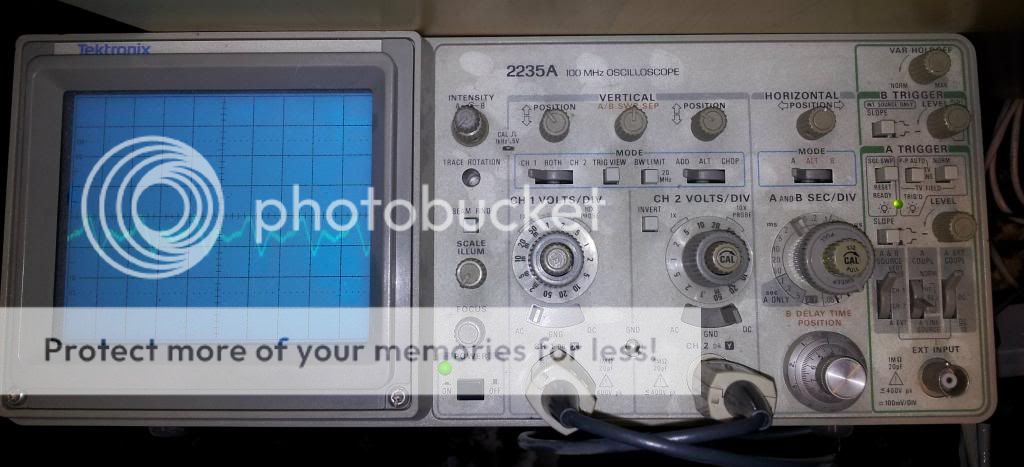Running the shunts from 37V is a bit much, try to run them from 30V or slightly less.
I've inserted two 50R, 10W resistors in line and I'm seeing 30v on the input to the shunt
Remove C105 and C205 and see if the oscillations/noise are/is gone.
Done...
Output did looks like this:
SEC/DIV is set at .1uS. V/DIV is 50mV.

Output now looks like this...
SEC/DIV is set at .05uS. V/DIV is 10mV.

When DC coupled the board's output waveform wanders up and down the screen by 20mV or so, with no defined period. Note I don't have the 20k resistor between output and GND. Even when AC coupled the waveform wanders by 5mV.
The GND, Power lines, input pin, just about everywhere are contaminated like this:
SEC/DIV is set at .05uS. V/DIV is 10mV.

I have tried unplugging everything else on the ring main other that the 'scope and the board's PSU...but nothing seems to affect the contamination.
Still feeling a couple of transistors being too hot, Q18 notably.
Last edited:
@chiily, IMO you are using BC327/337 with very high Hfe's in the PSU, it is not exactly oscillating but it is regulating as expected in a kind of semi-SMPS-mode (I would call it  ). You could try to use BC's with a lower Hfe or you could try to lower R100, 103, 200 and 203 from 330ohm down to 47ohm. Be sure that C105, 205 are of a high-esr (cheap) type (do not use low-esr capacitors here). Also you could try to add a small (10/20pf or so) capacitor between B and C of Q105, 205.
). You could try to use BC's with a lower Hfe or you could try to lower R100, 103, 200 and 203 from 330ohm down to 47ohm. Be sure that C105, 205 are of a high-esr (cheap) type (do not use low-esr capacitors here). Also you could try to add a small (10/20pf or so) capacitor between B and C of Q105, 205.
Last edited:
What is such a "regulator" good for?? Why not to use standard solution where we can easily achieve excellent results?
At this stage it is mere speculation it's the regulator to blame. Some builds, quite notably mine, suffer from hf oscillation, rapidly changing offset and excessive noise. Others apparently work perfectly.
Shunt regulators with CCS have a tradition here on DIYAUDIO so we implemented one.
There are even bridges between the regulator and the main board so feel free to build your own " standard solution" that can " easily achieve excellent results ".
Of cause we are watching and discussing in the back round how to help the builders to get the Paradise working as intended.
I had no trouble with Frans PSU so far.
There are even bridges between the regulator and the main board so feel free to build your own " standard solution" that can " easily achieve excellent results ".
Of cause we are watching and discussing in the back round how to help the builders to get the Paradise working as intended.
I had no trouble with Frans PSU so far.
Hi PavelWhat is such a "regulator" good for?? Why not to use standard solution where we can easily achieve excellent results?
These are high current shunt regs... it´s inherent low output impedance makes them the best choice for an aplication like this one... IMO even beter than lead batteries.
Anyway this is DIY in it´s best...
You will only be convinced after you hear one complete build... Outstanding results can be expected.
What is such a "regulator" good for?? Why not to use standard solution where we can easily achieve excellent results?
I do not understand what you try to accomplish with a post like this. How is it going to help?
How is it going to help? I found this thread accidentally, and I have read here that many people have troubles with LF oscillations, HF oscillations, several days waiting for DC to settle and whatever else. It is absolutely clear from their posts and measurements shown. If it was one or two builders, I would believe they made some mistake. But such occurrence of various troubles indicates to a serious design flaw or flaws. So the help might be if authors would try to find the real reasons of both LF and HF instability and bring solution. Yes it is for the DIYers. When I have seen how complicated circuit was suggested to people who are often inexperienced in electronic circuits, I was very surprised. So you authors are supposed to bring solution and help the builders.
So you authors are supposed to bring solution and help the builders.
It is apparently impossible to replicate the problem, strange as it may seem. Most likely it's due to some strange inconsistencies in the parts. Beta was a chief suspect at some stage but proved to be a red herring.
Otoh i am not certain if anyone is entirely happy with the offset situation. What good is a servo if it cannot maintain dc conditions within say 5mV. 30-100mV at output clearly calls for a coupling cap or a different manner of maintaining dc stability.
We do. Hesener even offered one guy that he sends his board to him for trouble shooting.
He also made a PDF with detailed instructions.
Frans and i are posting and watching minimum 2 hours a day for free anyway.
Yes, the circuit is fast and complex but nothing against the initial R1 version.
After beta building 5 sets by different people we thought it was ok to release it.
Anyway, when somebody gets frustrated because of our work i really feel the pain.
He also made a PDF with detailed instructions.
Frans and i are posting and watching minimum 2 hours a day for free anyway.
Yes, the circuit is fast and complex but nothing against the initial R1 version.
After beta building 5 sets by different people we thought it was ok to release it.
Anyway, when somebody gets frustrated because of our work i really feel the pain.
So you authors are supposed to bring solution and help the builders.
And what do you think we are doing? The point is, if there is any thing where you can help you should, if not then don't. Just making non constructive remarks while others are trying to help will not resolve anything.
Hello there,
i dont know if it helps anyone.
But, before Chris/Take five, got his Paradise working,
he had very similar issues like noise, oszilation and so on.
He found his solution thru hooking up just one channel,
much better, but still a bit noisy.
Luckyly hes got some accus from his RC Hellacopta.
After installing double mono independent psus, just music !
Because those problems mentioned by other builders sound
similar to me, it might be helpful to know how EXACTLY their
PSUs are hooked up.
Possibly...
i dont know if it helps anyone.
But, before Chris/Take five, got his Paradise working,
he had very similar issues like noise, oszilation and so on.
He found his solution thru hooking up just one channel,
much better, but still a bit noisy.
Luckyly hes got some accus from his RC Hellacopta.
After installing double mono independent psus, just music !
Because those problems mentioned by other builders sound
similar to me, it might be helpful to know how EXACTLY their
PSUs are hooked up.
Possibly...
Last edited:
LF oscillations
In a high gain (80dB), DC coupled, servo controlled amplifier, I don't think you can get rid completely of the output LF fluctuations, even with shorted input. Just try it with a high gain, low noise opamp, like the LME4562, with a servo loop to minimize the output offset.
Core reason is the 1/f noise, increasing (in power) with 10dB/decade with decreasing frequency. At 0.1Hz (the typical range for these fluctuations), the noise power is 30dB higher than at the bipolar typical noise corner frequency. If the amp is DC connected, these noise "spikes" will happily be amplified by the 80dB gain, and the result are output fluctuations in the mV or 10's of mV range. Also consider that the servo loop is, for good reasons (like the problem of waiting for hours or days for the output to settle), not designed to cut very low frequencies, as a result exacerbating the LF fluctuation problem.
Others had similar issues as well. If you don't like it, you must give up DC coupling and use somewhere a cap (which, with the next stage input impedance, acts as a high pass filter). But even so, I don't think that very low frequency mV fluctuation at the MC output may have any audible impact, unless you are DC coupled up to the speakers.
If you don't like it, you must give up DC coupling and use somewhere a cap (which, with the next stage input impedance, acts as a high pass filter). But even so, I don't think that very low frequency mV fluctuation at the MC output may have any audible impact, unless you are DC coupled up to the speakers.
Hear Hear
100 % agree
Do me a favor stop quoting his post as he is in my ignore list and as ussual braggin about and with very litle constructive output.
Furthermore if your woofer is moving about a lot with your records and this get you realy pissed off feel free to send the lot to me for recyclin which I will do free of charge and get yourself an Ipod
Now seriously
TELL IN YOU A LAST TIME you need 2 suply for Paradise
In a high gain (80dB), DC coupled, servo controlled amplifier, I don't think you can get rid completely of the output LF fluctuations, even with shorted input. Just try it with a high gain, low noise opamp, like the LME4562, with a servo loop to minimize the output offset.
Core reason is the 1/f noise, increasing (in power) with 10dB/decade with decreasing frequency. At 0.1Hz (the typical range for these fluctuations), the noise power is 30dB higher than at the bipolar typical noise corner frequency. If the amp is DC connected, these noise "spikes" will happily be amplified by the 80dB gain, and the result are output fluctuations in the mV or 10's of mV range. Also consider that the servo loop is, for good reasons (like the problem of waiting for hours or days for the output to settle), not designed to cut very low frequencies, as a result exacerbating the LF fluctuation problem.
Others had similar issues as well. If you don't like it, you must give up DC coupling and use somewhere a cap (which, with the next stage input impedance, acts as a high pass filter). But even so, I don't think that very low frequency mV fluctuation at the MC output may have any audible impact, unless you are DC coupled up to the speakers.
Plausible... very good... so nothing to worry about... Even in a DC coupled system like mine,there is no audible effect from the very low mv fluctuations.
- Home
- Source & Line
- Analogue Source
- Paradise Builders